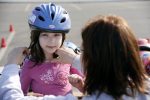(photo by Staff Sgt. Jim Araos)
More than 200 B.C. children were admitted to hospital last year with pedestrian, cycling or skateboard-related injuries and, of these, almost one-third had major injuries. With summer on the horizon, kids are back outside walking, biking, skating and having fun and it’s important to teach them to make good decisions that keep them safe and sound.
“This is the time of year where we begin to see more and more children in our emergency department with injuries related to bike, skateboard and scooter incidents – many of which are preventable,” said Lisa Romein, manager of B.C. Children’s Hospital trauma program. “As parents, we must educate ourselves and our children to be cautious but to have fun at the same time. We have the ability to prevent many of these injuries from ever happening and to help ensure the warmer months are memorable for all the right reasons.”
The B.C. Trauma Registry reports the following data for transport injuries in the province for kids ages 0-14 during 2015/16:
- Biking: 117 hospitalizations, 23 of them had major injuries
- Pedestrian: 57 hospitalizations, 33 of them had major injuries
- Skateboard: 28 hospitalizations, 3 of them had major injuries
“Sometimes, the fear of injuries can make it hard for parents to let their children get outside and be active,” said Dr. Mariana Brussoni, investigator with the B.C. injury research and prevention unit at B.C. Children’s Hospital, and associate professor with the University of British Columbia department of pediatrics. “But the benefits of active transportation far outweigh the risks. Our research has shown that children with opportunities for active transport are physically active, gain independence and self-confidence, and build the skills they need to stay safe.”
Safe Kids Week, an annual public awareness campaign aimed at reducing preventable injuries in children, was marked across Canada June 5 to 11. This year’s focus was active transportation safety. According to Parachute Canada, a national charitable organization dedicated to preventing injuries and saving lives and the organizer of Safe Kids Week, preventable injuries are the number one killer of Canadian children; one child dies every nine hours in Canada from a preventable injury; and, each year, approximately 4,700 children in Canada are injured due to non-motorized wheeled activities, and another 2,400 children are injured as pedestrians.
To keep kids safe on their travels, here are some tips from Parachute Canada:
- Teach kids at an early age to look left, right and left again when crossing the road.
- Always cross the street at corners. Use traffic signals and crosswalks.
- Walk on sidewalks or paths. No sidewalks? Then walk facing traffic as far away from vehicles as possible.
- Phones down, heads up when walking. Teach kids to put phones, headphones and other devices down when crossing the street.
- Be seen. Teach kids to be especially alert and visible to drivers when walking after dark. Brightly coloured clothing and reflective gear help increase visibility.
- Wear the right helmet for the activity. Bike helmets can be used for in-line skating and scootering, but skateboarding helmets should be used for skateboarding and longboarding; they cover the back of the head better and can protect against more than one crash.
- Be prepared. Bike safety training and knowing the rules of the road are important for the safety of riders.
- Always bike ride on the right side of the road in the same direction as traffic to be more visible to drivers.
- Teach kids on bikes to make sure drivers can see them at all times. Bright, reflective clothing and flashing lights and reflectors help increase visibility.
- When skateboarding, scootering or in-line skating, wear wrist guards to help prevent broken bones, sprains and wrist and arm fractures.
Elbow pads and kneepads should also be worn for in-line skating.
For more safety information, visit parachutecanada.org/skw-resources.

